

Blended learning and student engagement: What’s the connection?
Educación Superior, vol.. 19, núm. 30, 2020
Universidad Abierta para Adultos


Recepción: 23 Julio 2020
Aprobación: 14 Octubre 2020
Abstract: This research study explored the con- nection between blended learning and student engagement by using Vaughan, Cleveland-Innes, and Garrison’s (2013) seven principles of blended learning. An introduction to blended learning and student engagement is provided followed by an overview to the com- munity of inquiry framework and the seven principles. A mixed methods re- search approach was utilized to inves- tigate how these seven principles could be used to design, facilitate, and direct a blended course in higher education in order to promote student engagement and success.
Keywords: Hybrid learning, Higher education, principles.
Resumen: Esta investigación exploró la cone- xión entre el aprendizaje híbrido y la participación activa de los estudian- tes utilizando los siete principios del aprendizaje híbrido de Vaughan, Cle- veland-Innes y Garrison (2013). Se ofrece una introducción al aprendizaje híbrido y a la participación activa de los estudiantes, junto a una visión general del marco de la comunidad de investi- gación y de los siete principios. Se utili- zó un enfoque de investigación de mé- todos mixtos para investigar la forma en que estos siete principios podrían utilizarse para diseñar, facilitar y diri- gir un curso híbrido en la Enseñanza Superior a fin de promover la participa- ción activa y el éxito de los estudiantes.
Palabras clave: Aprendizaje híbrido, Enseñanza superior, principios.
INTRODUCTION
This research study investigates the connection between blended learning and student engagement by using Vaughan, ClevelandInnes, and Garrison’s (2013) seven principles of blended learning, which were derived from the Community of Inquiry framework (Garrison, 2017). The educational research literature (Dziuban, Graham, & Picciano, 2013) has indicated that a blended approach to teaching and learning might provide an optimal environment for enhancing student enga- gement and success. The idea of blending different learning experiences has been in existence since humans started thinking about teaching (Williams, 2003). The ongoing infusion of webased technologies into the learning and teaching process has highlighted the potential of blended learning (Allen & Seaman, 2010; Clark, 2003). Collaborative webbased applications have created new opportunities for students to interact with their peers, teachers, and content.
Blended learning is often defined as the combination of facetoface and online learning (Sharpe et al., 2006; Williams, 2002). Ron Bleed, the former Vice Chancellor of Information Technologies at Maricopa College, argues that this is not a sufficient definition for blended learning as it simply implies “bolting” technology onto a traditional course, using digital technologies as an add-on to teach a difficult concept, or adding supplemental information. He suggests that blended learning should be viewed as
an opportunity to redesign how courses are developed, scheduled, and delivered through a combination of physical and virtual instruction: “bricks and clicks” (Bleed, 2001). Joining the best features of inclass teaching with the best features of online learning that promote active, selfdirected learning opportunities with added flexibility should be the goal of this redesigned approach (Garnham & Kaleta, 2002; Littlejohn & Pegler, 2007; Norberg, Dziuban, Moskal, 2011). Garrison and Vaughan (2008) echo this sentiment when they state that
“blended learning is the organic integration of thoughtfully selected and complementary faceto-face and online approaches and technologies” (p.148).
A survey of elearning activity conducted by Arabasz, Boggs & Baker (2003) found that 80 percent of all higher education institutions and 93 percent of doctoral insti- tutions offer hybrid or blended learning courses.
The objective of this research study is to investigate how a blended course can be designed, facilitated, and directed to help students can become more engaged and successful in their academic studies.
BACKGROUND
Community of Inquiry Framework
Lipman (1991) has argued that education is inquiry. He suggests that “the community of inquiry is perhaps the most promising methodology for the
encouragement of that fusion of critical and creative cognitive processing known as higherorder thinking” (Lipman, 1991, p. 204). It is critical thinking that is most often cited as the hallmark of hi- gher education. Therefore, a community of inquiry could be the concept that best captures the ideal of a higher educational experience. It is through student engagement in a community of inquiry where teachers can create the conditions for critical thinking, rational judgments, and understanding. Both a sense of community and commitment to the process of inquiry must be in place.
The community of inquiry (CoI) model can be used as a framework to design, facilitate, and direct blended learning experiences in higher education. It has been the focus of extensive study and validation for over a decade (Garrison, 2017). The premise of the CoI framework is that higher education is both a collaborative and individually constructivist learning experience. A community of inquiry is where “students listen to one another with respect, build on one another’s ideas, challenge one another to supply reasons for otherwise unsupported opinions, assist each other in drawing inferences from what has been said, and seek to identify one another’s assumptions” (Lipman, 2003, p.20)
The three key elements or dimensions of the CoI framework are – social, cognitive, and teaching presence (Figure 1). It is at the convergence of these three mutually reinforcing elements that a collaborative constructivist educational experience is realized. Social presence creates the environment for trust, open communication, and group cohesion. Cognitive presence has been defined “as the extent to which learners are able to construct and confirm meaning through sustained reflection and discourse in a critical community of inquiry” (Garrison, Anderson, & Archer, 2001, p. 11). It has been operationalized through the developmental phases of inquiry triggering event, exploration, integration, and resolution. The third and cohesive element, teaching presence, is associated with the design, facilitation, and direction of a community of inquiry. It is the unifying force that brings together the social and cognitive processes directed to personally meaningful and educationally worthwhile outcomes.
thinking” (Lipman, 1991, p. 204). It is critical thinking that is most often cited as the hallmark of hi- gher education. Therefore, a community of inquiry could be the concept that best captures the ideal of a higher educational experience. It is through student engagement in a community of inquiry where teachers can create the conditions for critical thinking, rational judgments, and understanding. Both a sense of community and commitment to the process of inquiry must be in place.
The community of inquiry (CoI) model can be used as a framework to design, facilitate, and direct blended learning experiences in higher education. It has been the focus of extensive
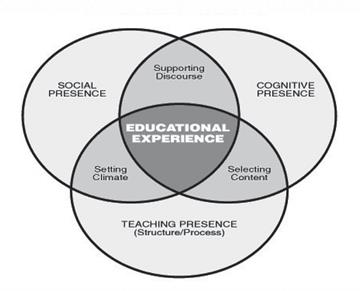
Seven Principles of Blended Learning
Principles are essential to translate theoretical frameworks into coherent practical strategies and techniques. Principles become even more valuable in coping with the complexities of integrating the potential of new and emerging communications technology. Our seven principles of blended learning have been deductively derived from the commu- nity of inquiry theoretical framework (Vaughan, ClevlandInnes & Garrison, 2013).
The principles are organized around the three subelements or categories of teaching presence design, facilitation, and direction. Within each of these three functions and areas of responsibility there are elements of social and cognitive
presence. Considering the complexity of a collaborative blended learning experience, considerable care and thought must be devoted to design, facilitation and direction. The following principles provide a map and guide to creating and sustaining purposeful communities of inquiry.
The seven principles are:
1. Plan for the creation of open communication and trust
2. Plan for critical reflection and discourse
3. Establish community and cohesion
4. Establish inquiry dynamics (purposeful inquiry)
5. Sustain respect and responsibility
6. Sustain inquiry that moves to resolution
7. Ensure assessment is congruent with intended processes and outcomes
The first two principles speak to the social and cognitive challenge of designing a collaborative blended learning experience. The next two principles address the social and cognitive concerns associated with facilitating a community of inquiry. And, the last three deal with the social, cognitive, and assessment responsibilities of directing or leading an educational experience to successfully achieve the desired outcomes.
The focus of this research study was on how these seven principles of blended learning (Vaughan, Cleveland-Innes, & Garrison, 2013) could be used to promote student engagement and success in a blended course.
Study Context
Mount Royal University in Calgary, Alberta, Canada offers a four year Bachelor of Education program. In the fall of the third year, teacher candidates are engaged in a series of blended learning experiences that focus on integrating Science, Technology, Engineering, Arts, Math, and Indigenous (STEAMI) education. This research study focuses on the educational technology course, which is part
of the STEAMI semester. The purpose of this blended course is to provide an overview of technological influences in education. It is designed to assist prospective teachers in critically examining current and evolving applications of technology relevant to the teaching and learning process.
Methodology
An action research methodology was used for this study. This approach involved teacher candidates reflecting on how a shared sense of engagement could be developed in a blended course. The intent of this research framework was to have some practical outcome related to the lives or work of the participants, which in this case was how they could successfully engage students in their future teaching practice. (Stringer, 2014). A mixed methods research approach guided the collection and analysis of the study data. Three sections of the educational technology course were offered in the fall 2019 semester and the coinvestigator invited the third year teacher candidates to participate in this research study. There were a total of eighty stu- dents enrolled in the course, seventy female (88%) and ten male (12%). Ninety percent of the students (n=72) agreed to participate in the study, which received Mount Royal University Human Re- search Ethics Board (HREB) approval.
In terms of quantitative methods, the validated Shared MC (Garrison & Akyol, 2015a) and CoI (Garrison, 2017)
surveys were both utilized in an online format using Google Forms. The shared metacognition survey (n=72) was deployed at the end of October, just before the teacher candidates began their five week practicum placements. The CoI survey was administered at the end of the fall 209 semester in order to observe how the teacher candidates had integrated their course experiences with their practicum placements (n=56). Descriptive statistics (frequencies, means, and standard deviations) were calculated for individual survey items using Google Spreadsheets. With regards to qualitative methods, at the end of the fall 2019 semester the teacher candidates created a final blog posting where they reflected on how they contributed to the learning of others in the course as well as what they had learned from their peers. This data was copied and pasted into a Google Document and the researchers used a constant comparative approach when reviewing the blog posts in order to identify patterns, themes, and categories of analysis that “emerged out of the data rather than being imposed on them prior to data collection and analysis” (Patton, 1990, p. 390).
Results
The study findings regarding student engagement in a blended course are reported using Vaughan, Clevelandnnes, and Garrison’s (2013) seven principles of blended learning.
Design & Organization: Principles One and Two
Course design is a planning process that includes consideration of many content and process issues. The focus of the plan- ning process for this research study was specifically on developing a shared sen- se of student engagement in a blended course.
At the beginning of the semester, the course instructor for the educational technology course had the students create an initial blog posting where they described and shared their personal learning goals for the course as they related to the MRU B.Ed. program’s five teaching competencies (planning, facilitation, assessment, classroom environment, professional roles and responsibilities). At the end of the semester, the students were required to demonstrate and describe how they had achieved these learning goals by presenting the teaching competency pages of their professional learning plan or ePortfolio.
The study participants indicated these activities were useful on a personal level but several commented on the importance of the teacher “going over all assignments at the beginning of the semester to allow students to ask questions and also give us time to wrap our heads around the key concepts and goals of the course” (Shared MC survey participant 25). This comment was also reflected in the results from question two of the Community of Inquiry (CoI) survey, which asked stu- dents if their teacher clearly communicated important course goals (Figure 2).
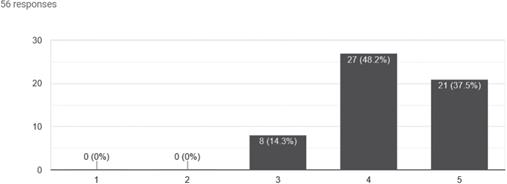
The 5 point Likerttype scale for this figure ranges from strongly disagree (1) to strongly agree (5). Figure 3 indicates that the majority of students thought the teacher clearly communicated the course goals but fourteen percent of the participants were ambivalent (on the fence).
Interestingly, in the final blog posting several students identified the benefit of group work in gaining a clearer unders- tanding of the course and assignment expectations. “It made it easier to understand the course expectations and added more perspectives as to how to approach assignments when we worked in groups” (Student blog posting 59). Another student commented that group work “ensures everyone is on the same page regarding assignment expectations” (Student blog 23).
Facilitation: Principles Three and Four Facilitation is the central activity in an educational community of inquiry for developing a shared sense of purpose
through the interactions between students and the teacher. Facilitative actions, “on the part of both the students and the instructor, create the climate, support discourse, and monitor learning. In the act of facilitation learners connect with each other, engage with the content, are cognitively present as intellectual agents, and carry out all actions central to the development and maintenance of the learning community” (Vaughan, Cleveland-Innes, & Garrison, 2013, p. 46). In essence, the teacher is responsible for modelling the growth and development of student engagement in a course.
For the educational technology course, the students selected critical friends at the beginning of the semester. The role of the critical friend was to provide constructive feedback and support for all of the course assignments. In addition, each of the course assignments had a group component where students were required to work together to solve problems and test solutions related to teaching with technologies.
The majority of research participants indicated that these collaborative activities helped them get to know the other students in course, which gave them a sen-
se of belonging (Figure 3) and allowed them to feel comfortable interacting with their peers (Figure 4).
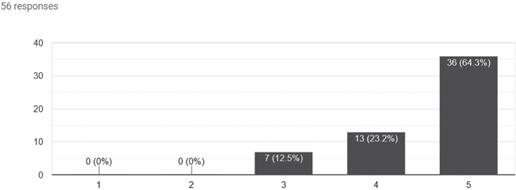
Highlighting the results of Figure 7, one student commented in her final blog posting that through group work “we
wereable to gain confidence about our individual ideas with support from our peers” (Student blog 71).
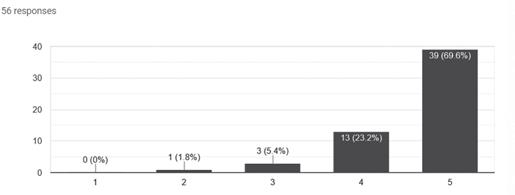
Another student indicated that his high level comfort in group work contributed to “Creating stronger working connections with peers, sharing ideas and re-
sources, and receiving critical feedback, and strategies to improve teaching and planning” (Student blog 13).
In turn, this sense of a safe learning environment allowed the students to be more willing to listen to the comments of
others (Figure 5) as well as considering the feedback of their peers (Figure 6).
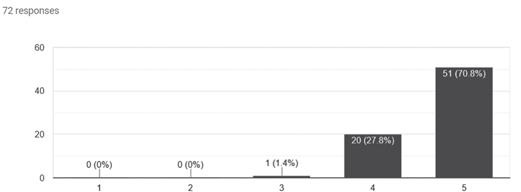
One participant emphasized that not only did she listen to others in the course “I got to learn from others. I was also
able to get new ideas and I was also able to share my ideas to others in my group” (Student blog 27).
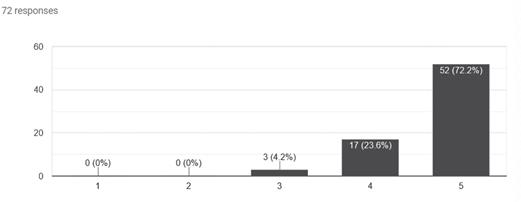
Many of participants in this study indicated that they had limited experience with peer feedback on assignments. For some, this requirement for all course assignments was rea revelation. “Working on an assignment and submitting it with
zero feedback is a source of anxiety for me. However, having group members to give me constructive feedback on my assignments was the biggest advantage for me with group work” (Student blog 36).
Direct Instruction: Principles Five, Six, and Seven
Direct instruction is not about lecturing
Direct instruction is about ensuring the students achieve the intended learning outcomes of a course or program. It is an essential ingredient in any formal educational experience in order to help students learn how to collaboratively manage and take responsibility for their learning. It has been shown that students
expect structure and leadership in higher education courses and the roles and responsibilities for direct instruction should be shared by all members of a community of inquiry (Garrison & Cleveland-Innes, 2005).
In terms of student engagement, some study participants indicated that they found it difficult to challenge their peers’ strategies and perspectives (Figures 7 and 8).
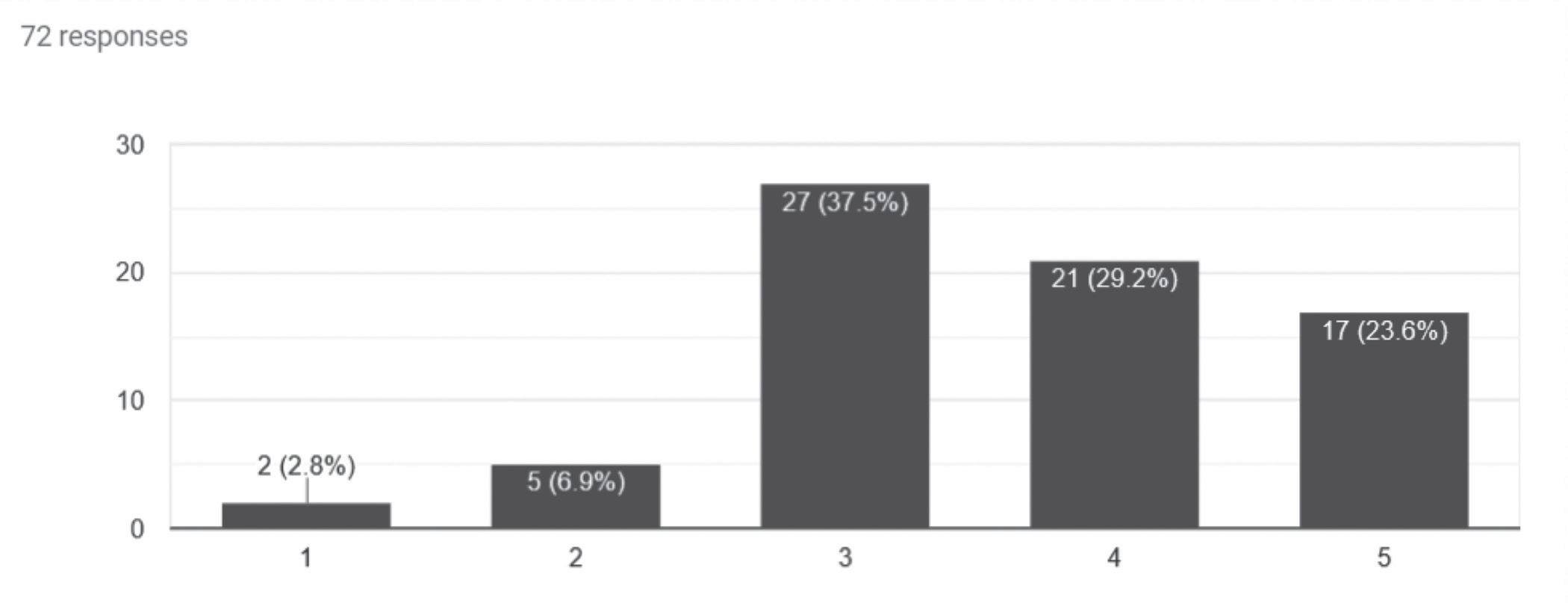
With regards to strategies, the participants commented specifically on work ethic and quality of work. Several of the students quoted the Pareto principle (Azad, 2013) where 20% of the group does 80% of the work “usually one or two people ended up doing the work while other group members didn’t do anything” (Student blog 11). And, inter-
ms of quality, one participant commented that “being able to trust others and their level of work is something I found difficult. I always want to try to strive for perfection (even when unattainable) so if I feel others are not as invested or do not put in as much work/effort it makes me upset” (Student blog 52).
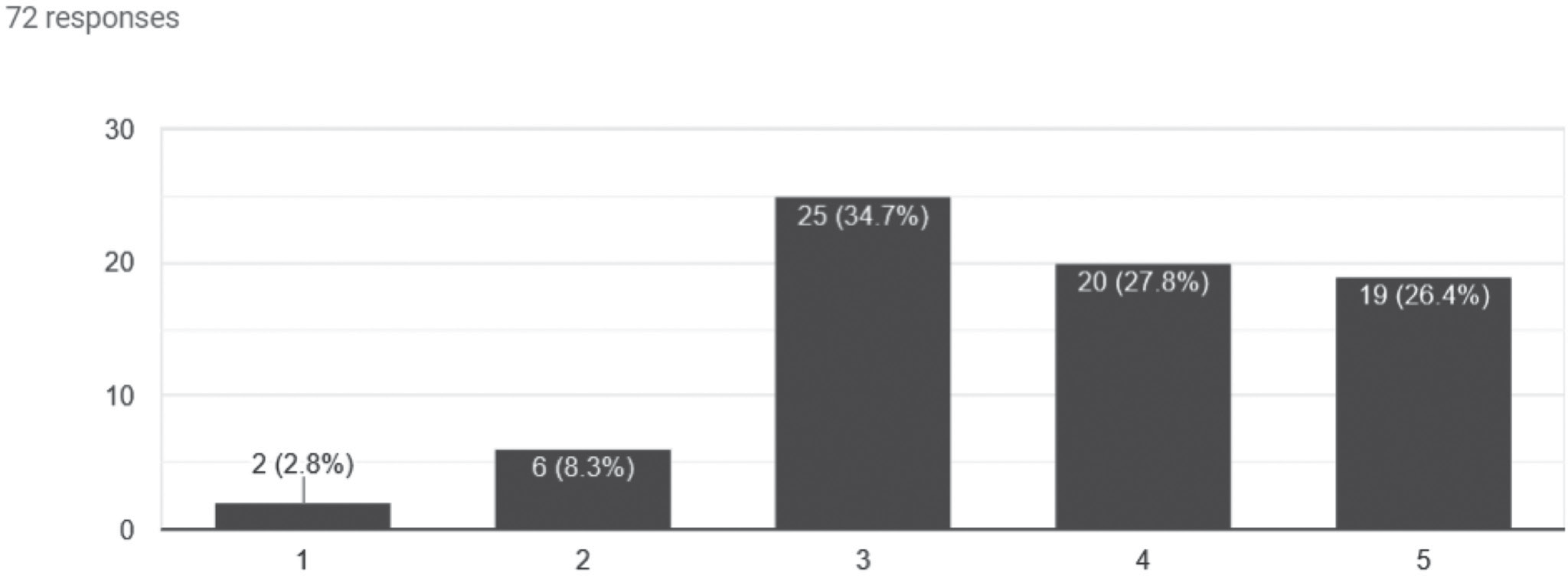
There were several comments about the challenge of negotiating different perspectives in group work. For example, one participant stated that “Sometimes it can be difficult to cooperate with others that have different ideas and values. However, this is still a valuable experience” (Student blog 13). Another student explained how overcoming this type of challenge can be an important learning experience. “I had some group members that were quick to shut down others’ ideas without backing up why. This was frustrating and at times hard to deal with, but it taught me to speak up and skills to positively work
through an uncomfortable situation” (Student blog 33).
Finally, students are often unwilling to disagree or challenge each other in a higher education course, especially in online discussion forums as they do not want to offend or hurt anyone’s feelings, a sense of “pathological politeness” (Garrison, 2017. p.53). From the CoI survey results and the final blog postings, it was encouraging to see that by working in groups over the semester the study participants became more comfortable with providing direct instruction to each other (Figure 9).

“I got to know more students in my program and made new friendships. These friendships helped me by providing me with people I trust to go to for information. They are people that I feel comfortable sharing my ideas with and taking risks with in terms of disagreements” (Student blog 47). Another student commented that “. . . this course helped me to formulate my teaching philosophy that knowledge is coconstructed through shared learning experiences. By working in groups I didn’t feel like I was working to build understanding alone” (Student blog 63).
Discussion
Based on the findings from this study a series of recommendations are made for how the seven principles of blended learning (Vaughan, ClevelandInnes, & Garrison, 2013) can be used to promo- te student engagement and success in a blended course.
Design and Organization: Principles One and Two
In terms of student engagement, Littky and Grabelle (2004) emphasize the importance of establishing relevance at the beginning of a course (1st R of engagement). They indicate that students should have a sense of curiosity and connectedness with the learning outco- mes for the blended course. This can be achieved by having students complete an online needs assessment survey, share their relevant experiences in an online
discussion forum, and create their own learning goals for the course in a blog.
Prior to the commencement of the blended course, the teacher can have students complete an anonymous needs assessment survey where they are asked about their expectations for the course. Questions could include the following:
1. What are your goals for this course; bottom line - what do you want to ‘take away’ from your course experience?
2. What do you expect will happen during the class sessions? What will the professor do in class and what will you do?
3. What type of work do you expect to do outside of the classroom for this course, if any?
4. How do you think your learning in this course will be assessed?
5. What type(s) of assistance with your learning do you expect to receive in this course and from whom?
This online survey can be constructed using applications such as Google Forms and SurveyMonkey. The key is to share and discuss the survey results with the students during the first class. The teacher can assign the students to small groups where they discuss the results and then share key findings with the entire class.
Also, during the first week of the course, students can be engaged in an exercise where they each reflect back on an event that was a very powerful learning experience for them it might or might not have been school related. The teacher can create a series of online discussion forums in the course learning management system (LMS) and then randomly assign five to six students to each forum. First, have the students share their learning experiences in their small groups and discuss why they were powerful. Second, debrief as a whole class about what makes learning experiences powerful and then using the CoI framework cocreate a set of engagement guidelines for the course.
Finally, students can use applications such as Google’s Blogger and WordPress to create reflective learning blogs for the course. In their first post, students can identify their personal learning goals for the course or program. The students can then select critical friend(s) who are responsible for providing them with constructive feedback and support on the course assignments such as replying to blog postings.
Facilitation: Principles Three and Four The second R of engagement that Littky and Grabelle (2004) advocate for is relationships. Creating a sense of community and collaboration are key for helping students engage and succeed in a blended course. Unfortunately, studies indicate that many students in higher education have little formal experience working co-
llaboratively in groups (Chang & Brick- man, 2018). Thus, the teacher must model the type of engagement behaviours they expect from the students and pro- vide opportunities for students to learn how to work successfully in groups.
For example, collaborative activities can be designed that allow students to experience all five stages of Tuckman’s (1965) group development model (e.g., forming, storming, norming, performing, and ad- journing). Ideally, this should be a lowstakes activity that takes place at the beginning of the semester so that students can obtain a first attempt in learning (FAIL) experience. In the case of an educational technology course this could involve students collaboratively working together on a case study in order to come up with a solution to a schoolrelated problem or issue (Schoology Exchange, 2017).
In addition, the participants of this study indicated that they had limited experience with the peer review process. The University of California at Los Angeles (2019) has developed a Calibrated Peer Review (CPR) Tool. This webbased application allows students to learn how to provide constructive feedback to their peers. There are three components to the CPR process; student writing, calibration training, and peer review. The first phase involves students creating a written piece of work based on a topic and in a format specified by the teacher. The second phase involves calibration training. Students assess three ‘calibration’ sub-
missions against a detailed set of questions that address the criteria on which the assignment is based. Students individually assess each of these calibration submissions according to the questions specified by the rubric and then assign a holistic rating out of 10. Feedback at this stage is vital. If the assessments are poorly done and do not meet the teacher’s expectations, the students get a second try. The quality of the assessments is taken into account in the next step, which involves the assessment of real submissions from other students. Once the deadline for calibration training has passed, each student is given anonymous submissions by three other students. They use the same rubric to assess their peers’ work, this time providing comments to justify their assessment and rating. After they have completed all three they then assess their own submission (Likkel, 2012).
Direct Instruction: Principle Five and Six
Littky and Grabelle’s (2004) third R of engagement is rigour. In a higher education course, this can involve students completing a challenging problem, task or assignment that forces them to confront different perspectives and new ways of thinking. This process involves the teacher ‘nudging’ the students forward in their academic studies (Thaler & Sunstein, 2008). For example, students are often content to share and discuss ideas with each other but require a ‘gentle nu- dge’ to integrate and apply those ideas in course assignments and everyday life.
One recommendation for direct instruction is the explicit use of Garrison, Anderson, and Archer’s (2001) Practical Inquiry (PI) Model for course assignments. This model is based on the cognitive presence sphere of the Community of Inquiry framework and involves four phases of inquiry; triggering event, exploration, integration, and resolution. In online discussion assignments, students can use the PI model to selfcode their forum posts in order to help them develop their metacognitive awareness and abilities. For example, they can label their postings as being either a triggering event, an exploration, integration, or resolution comment.
Another recommendation involves the use of learning contracts for group work. This can be a useful tool for helping students to plan and complete collaborative inquirybased project work. These contracts should be constructed by the students and reviewed by the teacher for constructive feedback and suggestions for modification. Both the students and the teacher should sign the final version of the learning contract. The contract then serves as an outline for the project and a tool to aid in the assessment process. Modification of the learning contract may become necessary as the learning experience progresses. Modified contracts should be approved and signed by both the students and the teacher. Failure for a student to meet her or his contract obligations may result in expulsion from the team.
Conclusions
The historical ideal of education has been to learn in collaborative communities of inquiry (Lipman, 1991). The Maori of New Zealand refer to this as the concept of ako, which means to both teach and learn. (AltonLee, 2003). Ako recognizes the knowledge that both teachers and students bring to learning interactions, and it acknowledges the way that new knowledge and understandings can grow out of shared learning experiences. Hattie and Yates (2014) refer to this process as visible teaching and learning “When teachers SEE learning through the eyes of their students and when students SEE themselves as their own teachers” (p. 14). This research study has demonstrated the potential of a blended approach to teaching and learning to recapture this collaborative vision for higher education. The key is to redesign our blended and online courses for active and collaborative learning experiences that enable students to take responsibility for their learning and validate their understanding through discourse and debate with their peers.
BIBLIOGRAPHIC REFERENCES
Allen, I. E., & Seaman, J. (2010). Class differences: Online education in the United States, 2010, Babson Survey Research Group, The Sloan Consortium. Available online at: https://secure.onlinelearningconsortium.org/publications/survey/class_differences
AltonLee, A. (2003). Quality teaching for diverse students in schooling: Best evidence synthesis
Arabasz, P., Boggs, R. & Baker, M. B. (2003). Highlights of elearning support practices. Educause Center for Applied Research Bulletin, 9.
Asad, K. (2013). Understanding the pareto principle (the 80/20 rule). Website. https://betterexplained.com/articles/ understanding-the-pareto-princi- ple-the-8020-rule/
Bleed, R. (2001). A hybrid campus for a new millennium. Educause Review, 36 (1). 16-24.
Chang, Y., & Brickman, P. (2018). When group work doesn’t work: Insights from students. CBE life sciences education, 17(3), ar42. https://doi.org/10.1187/ cbe.17-09-0199
Chick, N. (2013)/ Metacognition. Centre for Teaching Vanderbilt University. Available online at:https://cft.vanderbilt. edu/guides-sub-pages/metacognition/
Chickering. A.W. & Gamson, Z.F. (1999). Development and adaptations of the seven principles for good practice in undergraduate education. New Directions for Teaching & Learning. 80, 75-82.
Clark, D. (2003). Blend it like Beckham. Epic Group PLC.
Dziuban, C., Graham, C. & Picciano, A.G. (2013). Research perspectives in blended learning: 2nd Edition. New York, NY: Routledge, Taylor and Francis.
Garnham, C. & Kaleta, R. (2002). Introduction to hybrid courses. Teaching with Technology Today, 8 (6). Available online at: https://www.wisconsin.edu/ systemwide-it/download/ttt.zip
Garrison, D. R. (2017). ELearning in the 21st century: A framework for research and practice (3rd Edition). London: Routledge/Falmer.
Garrison, D. R., & Vaughan, N. D. (2008). Blended learning in higher education. San Francisco: JosseyBass.
Garrison, D. R., & Cleveland-Innes, M. (2005). Facilitating cognitive presence in online learning: Interaction is not enough. American Journal of Distance Education, 19, 133-148. http://dx.doi. org/10.1207/s15389286ajde1903_2
Garrison, D. R., Anderson, T., & Archer, W. (2001). Critical thinking, cognitive presence, and computer conferencing in distance education. American Journal of Distance Education, 15(1), 17-23
Garrison, D. R., Anderson, T., & Archer, W. (2000). Critical inquiry in a textbased environment: Computer conferencing in higher education model. The Internet and Higher Education, 2(2-3), 87-105.
Graham, C. R. (2006). Blended learning systems: Definitions, current trends, and futuredirections. In Bonk, C. & Graham, C. (Eds), The handbook of blended learning: Globalperspectives, local designs (pp. 3-21). San Francisco, CA: Pfeiffer.
Hattie, J. & Yates, G.C.R. (2014). Visible learning and the science of how we learn. New York, NY: Routledge.
Kromydas, T. (2017). Rethinking higher education and its relationship with social inequalities: past knowledge, present state and future potential. Palgrave Commun 3, 1. Available online at: https:// www.nature.com/articles/s41599-017- 0001-8#citeas
Likkel, L. (2012). Calibrated peer review: Essays increase student confidence in assessing their own writing. Journal of College Science Teaching. 41(3), 42-47.
Lipman, M. (1991). Thinking in education. Cambridge University Press: New York.
Littky, D. & Grabelle, S. (2004). The big picture: Education is everyone’s business. Alexandria, VA: Association for Supervision and Curriculum Development.
Littlejohn, A., & Pegler, C. (2007). Preparing for blended eLearning: Understanding blended and online learning (Connecting with E-earning). London: Routledge.
Mayadas, F. A. & Picciano, A. G. (2007). Blended learning and localness: The means and theend. Journal of Asynchronous Learning Networks, 11(1), 3-7.
Moskal, P. D., Dziuban, C. D., & Hartman, J. (2013). Blended learning: A dangerous idea? Internet and Higher Education. 18(3), 15-23.
Nakoda Elementary School. (2020). Website. https://www. nakodaschool.ca/
Norberg, A., Dziuban, C. D., & Moskal, P. D. (2011). A timebased blended learning model. On the Horizon, 19(3), 207-216.
Patton, M.Q. (1990). Qualitative evaluation and research methods (2nd ed.). New- bury Park, CA: Sage Publications.
Power, M. (2008). The emergence of a blended online learning environment. MERLOT Journal of Online Learning and Teaching, 4(4), 503-514. Available online at: http://jolt.merlot.org/vol4no4/ power_1208.pdf
Regier, P., (2014, September/Octo- ber). Using technology to engage the nontraditional student. EDUCAUSE Review, 70-88. Available online at: ht- tps://er.educause.edu/articles/2014/9/ using-technology-to-engage-the-nontra- ditional-student
Schoology Exchange. (2017). Learning from Failure: 6 Short EdTech Case Studies You Need to Read. Available online at: https://www.schoology.com/blog/ learning-failure-6-short-edtech-case-studiesyouneeread
Sharpe, R., Benfield, G., Roberts, G., & Francis, R. (2006). The undergraduate experience of blended elearning: A review of UK literature and practice. London: Higher Education Academy.
Stringer, E.T. (2014). Action research (3rd ed.). Thousand Oaks, CA: Sage Publications.Telus SPARK
Science Centre. (2020). Website. https://www.sparkscience.ca/
Thaler, R., & and Sunstein, C. (2008). Nudge. New York: Penguin Books.
The Compass. (2020). Tim Horton’s Children’s Ranch. https://thethcompass.com/ camps/tim-hortonchildrensranch/
Tuckman, B. W. (1965). Developmental sequence in small groups. Psychological Bulletin, 63(6), 384–399.
University of California at Los Angeles. (2019). Calibrated Peer Review (CPR) Tool. http://cpr.molsci.ucla.edu/Home
Vaughan, N.D., ClevelandInnes, M. & Garrison, D.R. (2013). Teaching in blended learning environments: Creating and sustaining communities of inquiry. Athabasca: Athabasca University Press. Avai lable online at: http://www.aupress.ca/ index.php/books/120229
Vaughan, N.D., Auger, N., Sacher, M., & Sacher, M. (2013). A blended approach to Canadian First Nations education: The Sunchild elearning community. In. (L. Kyei-Blankson, & E. Ntuli, Eds.),Prac- tical Applications in Blended Learning Environments: Experiences in K-20 Education. Hershey, PA: IGI Global
Williams, J. (2003). Blending into the background. ELearning Age Magazine, 1.
Williams, C. (2002). Learning online: A review of recent literature in a rapidly expanding field. Journal of Further and Higher Education, 26(3), 263-272.

